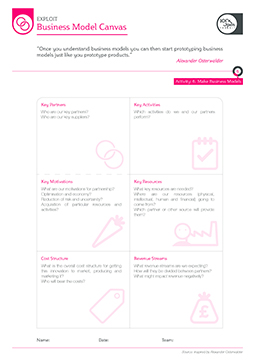Business Model Canvas
“Once you understand business models you can then startprototyping business models just like you prototype products”
Alexander Osterwalder


This tool is for creating a distinctive business model around our innovation. This step builds on the value proposition that we built using our Investable Proposition Templates and Open Innovation Models.
The Business Model Canvas was created by BusinessModelGeneration.com. However as this is open innovation we have prioritised the parts of the Business Model Canvas that are most relevant to effective partnerships: Key partners, Key Activities, Key Resources, Cost Structure and Revenue Streams.

First we learn the Business Model Canvas by choosing five or six competitors of our product, service or brand to serve as examples and analyse their business models using the canvas. We can then use these analyses to create a distinctive business model for our innovation.
We use the table below to analyse the norms and outliers in our sector, filling in one copy of the table per competitor. For this exercise we just need to write one sentence in each of the boxes:
-What are the similarities in business model across our sector?
-What are the points of difference between business models in our sector? (Which aspects might help us stand out from the competition? Where might our business model add value to users, consumers or partners?)
| Similar | Different | |
|---|---|---|
| Key Partners | ||
| Key Activities | ||
| Key Resources | ||
| Cost Structure | ||
| Revenue Streams |
Next we start to build our new business model. We will use an A3 printed version of the template and sticky notes to record our choices. Write each quickly to avoid becoming attached to a single polished idea, and tightly to fit on one sticky note. When presenting a completed business model, build it one sticky note at a time as you talk about the different sections.
As partnerships are critical for open innovation we answer these questions about their nature first:
• Who are our key partners?
• Who are our key suppliers?
• Which key resources are partners acquiring from each other?
• Which key activities do we and our partners perform?
Then we turn to our motivations for partnership. Which of these apply? Any others?
• Optimization and economy
• Reduction of risk and uncertainty
• Acquisition of particular resources and activities
• Which activities will each partner be responsible for now and in the future?
• What key resources are needed?
• Where are our resources (physical, intellectual, human and financial) going to come from?
• Which partner or other source will provide them?
• What is the overall cost structure for getting this innovation to market, producing and marketing it?
• Who will bear these costs?
• What revenue streams are we expecting?
• How will they be divided between partners?
• What might impact revenue negatively?
We should have written our first canvas quickly and so now we can come back and look at a number of alternatives, trying out as many different plans as time allows. For example:
• Sketch out each idea on a separate canvas. For example, use two different canvases for two very different customer segments.
• Sketch out diametrically opposed models. For example, ask yourself “what if I offered my product for free…” vs. “what if I offered my product only to the very high-end market…”
Finally we can choose a business model that we all agree is the most promising and revisit it in more detail. Then it is a good idea to gather feedback from colleagues in different departments and partners who weren’t able to contribute. For example if our model depends heavily on a particular channel or customer type we will need to speak to our channel partners or marketing colleagues.
Source: Inspired by Alexander Osterwalder. The Business Model Canvas was created by BusinessModelGeneration.com under a creative commons licence (like the 100%Open Innovation Toolkit!) and you can download it along with instructions.
You must be logged in to download this tool
You must be logged in to download this worked example
2014 - 100%OPEN LTD